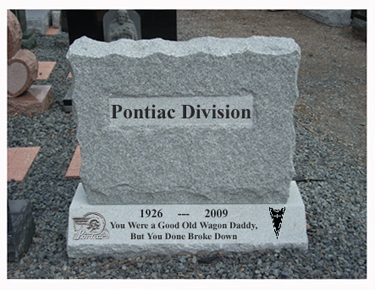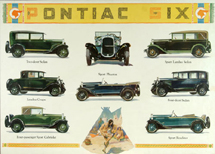Part I: Abrogation of the Enterprise’s Principles
Dear General Motors; this means everyone: Executives, workers, board members, retirees, investors, dealers, suppliers, buyers of our brands.
The golden goose is dead. It shouldn’t have come to this, since the General Motors enterprise was built deliberately to be adaptable to any circumstances – to seize opportunities when times were good, and to retrench effectively when times were bad. When did you all decide that this strategic policy was no longer your responsibility?
I’m not going to say that GM should avoid bankruptcy. File today rather than Monday. It is the only avenue that makes sense, and in fact is simply the now-unavoidable admission that the company has been effectively bankrupt for years, but has merely been shifting the evidence from one pocket to another: One year product would be uncompetitive; another year there would be a financial loss. The proliferation of brands and markets added more shells to the game, but eventually it came down to pulling sales ahead from the next quarter by looting GMAC to offer free credit.
There is plenty of blame to go around. It falls upon every constituency over the course of generations. The union and the dealer body are guilty of sins of commission, in seeking and instituting unfair advantages. The others are guilty of sins of omission, by angling ever for their “piece” of General Motors, even the crumbs.
But the primary failure has been lack of leadership by those who held responsibility – the management and governance bodies. Many men have held the CEO position since I relinquished it; few have led the company. Many notable executives have filled seats on the board, but none has made the corporation’s long-term survival their cause. These groups were properly in possession of the “culture” of General Motors, and they carelessly allowed it to fall from their hands.
There is no mystery to the failure, and so there is no hiding from it by those who were responsible. But perhaps even more shameful is that there was also no mystery to the great success of General Motors over the course of nearly five decades. It’s all in my memoir, My Years with General Motors. I wrote it at the height of General Motors’s success, but not so long after the Depression that I imagined our success to be perpetual. How many managers and directors have ever read it? How many of you who did read it actually studied it? It’s not without flaws, and it betrays its age as well as my own obsessions. But it maps the soul of a great enterprise. In the Introduction, I wrote:
Obstacles … and new horizons arise to stir the imagination and continue the progress of industry. Success, however, may bring self-satisfaction … When such influences develop, growth may be arrested or a decline may set in, caused by the failure to recognize advancing technology or altered consumer needs, or perhaps by competition that is more virile and aggressive.
That’s not visionary, simply in touch with the constant reality that challenges will arise whether you can identify them or not. In the 1920s, we were that more virile and aggressive competitor when we overcame Ford’s domination in the 1920s and established our industry leadership. Our success rested on a handful of core principles: That our managers understood their customers and were capable to answer their demands; that our customers made good automobile choices when given good choices to make; that each business must be competitive in its own right, that long-term growth was more valuable than short-term gain; that industry leadership meant embracing change; and that policy was formulated by consensus, while its administration was carried out by individuals.
And the one overriding principle that served as the foundation for the rest was that we would endeavor to get the facts and act upon them. I state my pride throughout My Years at the corporation’s commitment to being a fact-based organization, which I believe it truly had been in my time as CEO (1923 – 1946). Yet I must also admit that, by the time of my retirement as Chairman in 1956, our culture of facts was already being subverted by a culture of fear among the new generation of leaders. Government trust-busters became an imagined enemy. So to did a more activist union and antagonists like Ralph Nader. Leadership imagined itself surrounded – General Motors, surrounded! – and instead of confronting these facts and devising solutions to the issues based on them, they retreated behind a comfortable market share based on old technology and the greatest self-delusion that an enterprise can hold – an unchanging market. Within the walls, the old facts still obtained, and new ones were not allowed to breach.
Facts were still ascertained, but only within the accepted context, and with a patina of fear overlaying every thought and move. Thus, the utility of facts in general was degraded, and initiative to act on them dissipated. The abrogation of our fact-oriented principle has eroded the foundation that underlay all the other principles. First to be subverted, in the 1970s, was our system of decentralized management. Independent divisions, which had been free to address their market segment as they saw fit, were turned against one another in the same segments by the centralized assignment of invented product distinctions. This led in the 1980s to the perversion of our long-successful multi-brand strategy, wherein brands that had actually been meaningfully distinct, were now almost comically identical, only with different badges.
Coming in Part II: Dissolution of the Enterprise’s Characteristics
 Unlike Buick, Cadillac and Chevrolet, Pontiac was not one of originally independent companies that William S. Durant amalgamated into General Motors between 1908 and 1918. Durant had collected nearly a dozen automobile truck and tractor brands, which Pierre du Pont whittled down in the crisis of 1921 to Cadillac, Buick, Olds, Oakland and Chevrolet (GMC represents the amalgamation of three truck brands).
Unlike Buick, Cadillac and Chevrolet, Pontiac was not one of originally independent companies that William S. Durant amalgamated into General Motors between 1908 and 1918. Durant had collected nearly a dozen automobile truck and tractor brands, which Pierre du Pont whittled down in the crisis of 1921 to Cadillac, Buick, Olds, Oakland and Chevrolet (GMC represents the amalgamation of three truck brands). Sloan’s gambit was the beautifully-executed, Chevrolet-based 1926 Pontiac. It quickly eclipsed the “damaged” Oakland brand, but never embodied the ancestral brand value that helped Cadillac, Buick, Olds, and Chevrolet endure the Depression with strength and surge after World War II, when Pontiac became stale.
Sloan’s gambit was the beautifully-executed, Chevrolet-based 1926 Pontiac. It quickly eclipsed the “damaged” Oakland brand, but never embodied the ancestral brand value that helped Cadillac, Buick, Olds, and Chevrolet endure the Depression with strength and surge after World War II, when Pontiac became stale.
Recent Comments